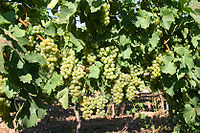Faber (grape variety)
The white wine variety Faber , also called Faberrebe , was crossed from Chardonnay and Müller-Thurgau in 1929 by Georg Scheu at the State Institute for Vine Breeding in Alzey . The breeder's original information that it was a cross between Pinot Blanc and Müller-Thurgau has since been refuted by a DNA analysis by Di Vecci-Staraz in 2009. The variety protection as well as the entry in the variety list took place in 1967. This white wine variety produces distinctly fruity wine with a characteristic light nutmeg aroma (-> aromas in the wine ). Due to its high acidity , the Faberrebe delivers fresh and classy wines. Because of the early ripeness, smaller plantings in England are known in addition to the stands in Germany.
In 2008, some wineries launched an initiative "Relaunch F" to give the increasingly forgotten variety a new image and to improve its marketing opportunities again.
See also the articles Viticulture in Germany and Viticulture in the United Kingdom and the list of grape varieties .
Synonyms: Faberrebe, breed number Az 10375
Parentage: Chardonnay x Müller-Thurgau
distribution
In Germany in 2007 632 hectares (= 0.6% of the German vineyard area) were planted with the Faber grape variety. In 2006 there were still 689 hectares of arable land, after 1657 hectares were surveyed in 1999.
| Wine region | Vineyards (hectares) |
| Ahr | - |
| to bathe | below 0.5 |
| Francs | 9 |
| Hessian mountain road | - |
| Middle Rhine | 1 |
| Moselle | 1 |
| Near | 32 |
| Palatinate | 55 |
| Rheingau | 1 |
| Rheinhessen | 533 |
| Saale-Unstrut | below 0.5 |
| Saxony | - |
| Stargarder Land | - |
| Württemberg | below 0.5 |
| TOTAL Germany 2007 | 632 |
Source: Vineyard statistics from March 13, 2008, Federal Statistical Office , Wiesbaden 2008 in Descriptive Variety List of the Federal Variety Office 2008, page 198ff.
Ampelographic varietal characteristics
In ampelography , the habitus is described as follows:
- The shoot tip is open. It has medium to strong hairy white wool.
- The leaves (see also the article leaf shape ) are three- to five-lobed and deeply indented. The stem bay is V-shaped open. The leaf margin is bluntly serrated. Compared to other grape varieties, the teeth are set medium wide. The leaf surface (also called blade) is slightly blistered.
- The cylindrical grape is medium-sized and has loose to dense berries. The slightly elongated berries are medium-sized and green-yellow in color.
The slow-growing Faber vine ripens from mid-September. The ripening takes place early to medium early. The berries are not particularly susceptible to botrytis . On the other hand, there is a susceptibility to stalk paralysis , which can be counteracted by suitable cultivation measures. In addition, it tends to develop stinginess , which leads to a slightly increased foliage work in the vineyard.
A must weight of 80–85 degrees Oechsle can be achieved at 100–150 hl / ha. The variety produces consistently high yields, so that targeted vine training should reduce the yield in order to achieve good wine quality. With low must weights, the wine can have unpleasant aromas.
literature
- Pierre Galet , Michel Grisard: Dictionnaire encyclopédique des cépages . Hachette, Paris 2000, ISBN 2-01-236331-8 (French).
- Walter Hillebrand, Heinz Lott, Franz Pfaff: Paperback of the grape varieties . 13th, revised edition. Fachverlag Fraund, Mainz 2003, ISBN 3-921156-53-X .
- Jancis Robinson : The Oxford Wine Lexicon . 3rd, completely revised edition. Hallwag, Munich 2007, ISBN 978-3-8338-0691-9 .
Web links
- Faber in the database Vitis International Variety Catalog of the Institute for Grapevine Breeding Geilweilerhof (English)
Individual evidence
- ↑ Erika Maul, Fritz Schumann, Bernd HE Hill, Frauke Dörner, Heike Bennek, Valérie Laucou, Jean-Michel Boursiquot, Thierry Lacombe, Eva Zyprian, Rudolf Eibach, Reinhard Töpfer: Focus on the crossing parents of German new varieties of vines - what does the genetic fingerprint say. In: German Viticulture Yearbook . Vol. 64, 2013, ISSN 0343-3714 , p. 128-142 .
- ↑ "Relaunch F" ( Memento of the original from December 10, 2011 in the Internet Archive ) Info: The archive link was automatically inserted and not yet checked. Please check the original and archive link according to the instructions and then remove this notice.
- ^ German Wine Institute : Statistics 2008/2009 . Mainz 2008 ( deutscheweine.de ( memento from March 23, 2012 in the Internet Archive ) [PDF; 454 kB ]).
- ^ German Wine Institute : Statistics 2007/2008 . Mainz 2007 ( deutscheweine.de ( memento from September 20, 2008 in the Internet Archive ) [PDF; 430 kB ]).
- ↑ German Wine Institute : Statistics 2004/2005 . Mainz 2004 ( deutscheweine.de ( memento from September 20, 2009 in the Internet Archive ) [PDF; 777 kB ]).
- ↑ Descriptive list of varieties of the Federal Plant Variety Office 2008 (PDF; 519 kB)
